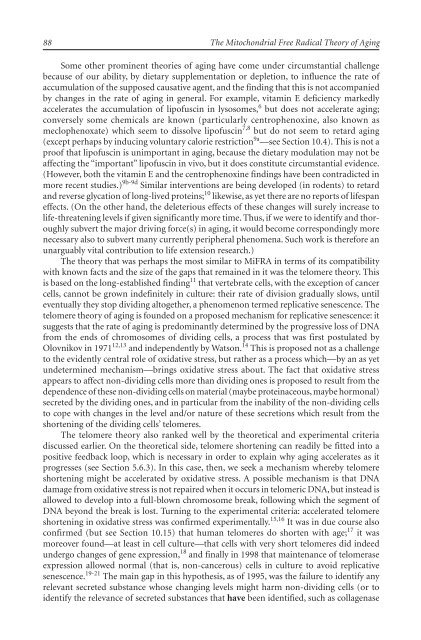The Mitochondrial Free Radical Theory of Aging - Supernova: Pliki
The Mitochondrial Free Radical Theory of Aging - Supernova: Pliki
The Mitochondrial Free Radical Theory of Aging - Supernova: Pliki
You also want an ePaper? Increase the reach of your titles
YUMPU automatically turns print PDFs into web optimized ePapers that Google loves.
88<br />
<strong>The</strong> <strong>Mitochondrial</strong> <strong>Free</strong> <strong>Radical</strong> <strong>The</strong>ory <strong>of</strong> <strong>Aging</strong><br />
Some other prominent theories <strong>of</strong> aging have come under circumstantial challenge<br />
because <strong>of</strong> our ability, by dietary supplementation or depletion, to influence the rate <strong>of</strong><br />
accumulation <strong>of</strong> the supposed causative agent, and the finding that this is not accompanied<br />
by changes in the rate <strong>of</strong> aging in general. For example, vitamin E deficiency markedly<br />
accelerates the accumulation <strong>of</strong> lip<strong>of</strong>uscin in lysosomes, 6 but does not accelerate aging;<br />
conversely some chemicals are known (particularly centrophenoxine, also known as<br />
meclophenoxate) which seem to dissolve lip<strong>of</strong>uscin 7,8 but do not seem to retard aging<br />
(except perhaps by inducing voluntary calorie restriction 9a —see Section 10.4). This is not a<br />
pro<strong>of</strong> that lip<strong>of</strong>uscin is unimportant in aging, because the dietary modulation may not be<br />
affecting the “important” lip<strong>of</strong>uscin in vivo, but it does constitute circumstantial evidence.<br />
(However, both the vitamin E and the centrophenoxine findings have been contradicted in<br />
more recent studies.) 9b-9d Similar interventions are being developed (in rodents) to retard<br />
and reverse glycation <strong>of</strong> long-lived proteins; 10 likewise, as yet there are no reports <strong>of</strong> lifespan<br />
effects. (On the other hand, the deleterious effects <strong>of</strong> these changes will surely increase to<br />
life-threatening levels if given significantly more time. Thus, if we were to identify and thoroughly<br />
subvert the major driving force(s) in aging, it would become correspondingly more<br />
necessary also to subvert many currently peripheral phenomena. Such work is therefore an<br />
unarguably vital contribution to life extension research.)<br />
<strong>The</strong> theory that was perhaps the most similar to MiFRA in terms <strong>of</strong> its compatibility<br />
with known facts and the size <strong>of</strong> the gaps that remained in it was the telomere theory. This<br />
is based on the long-established finding 11 that vertebrate cells, with the exception <strong>of</strong> cancer<br />
cells, cannot be grown indefinitely in culture: their rate <strong>of</strong> division gradually slows, until<br />
eventually they stop dividing altogether, a phenomenon termed replicative senescence. <strong>The</strong><br />
telomere theory <strong>of</strong> aging is founded on a proposed mechanism for replicative senescence: it<br />
suggests that the rate <strong>of</strong> aging is predominantly determined by the progressive loss <strong>of</strong> DNA<br />
from the ends <strong>of</strong> chromosomes <strong>of</strong> dividing cells, a process that was first postulated by<br />
Olovnikov in 1971 12,13 and independently by Watson. 14 This is proposed not as a challenge<br />
to the evidently central role <strong>of</strong> oxidative stress, but rather as a process which—by an as yet<br />
undetermined mechanism—brings oxidative stress about. <strong>The</strong> fact that oxidative stress<br />
appears to affect non-dividing cells more than dividing ones is proposed to result from the<br />
dependence <strong>of</strong> these non-dividing cells on material (maybe proteinaceous, maybe hormonal)<br />
secreted by the dividing ones, and in particular from the inability <strong>of</strong> the non-dividing cells<br />
to cope with changes in the level and/or nature <strong>of</strong> these secretions which result from the<br />
shortening <strong>of</strong> the dividing cells’ telomeres.<br />
<strong>The</strong> telomere theory also ranked well by the theoretical and experimental criteria<br />
discussed earlier. On the theoretical side, telomere shortening can readily be fitted into a<br />
positive feedback loop, which is necessary in order to explain why aging accelerates as it<br />
progresses (see Section 5.6.3). In this case, then, we seek a mechanism whereby telomere<br />
shortening might be accelerated by oxidative stress. A possible mechanism is that DNA<br />
damage from oxidative stress is not repaired when it occurs in telomeric DNA, but instead is<br />
allowed to develop into a full-blown chromosome break, following which the segment <strong>of</strong><br />
DNA beyond the break is lost. Turning to the experimental criteria: accelerated telomere<br />
shortening in oxidative stress was confirmed experimentally. 15,16 It was in due course also<br />
confirmed (but see Section 10.15) that human telomeres do shorten with age; 17 it was<br />
moreover found—at least in cell culture—that cells with very short telomeres did indeed<br />
undergo changes <strong>of</strong> gene expression, 18 and finally in 1998 that maintenance <strong>of</strong> telomerase<br />
expression allowed normal (that is, non-cancerous) cells in culture to avoid replicative<br />
senescence. 19-21 <strong>The</strong> main gap in this hypothesis, as <strong>of</strong> 1995, was the failure to identify any<br />
relevant secreted substance whose changing levels might harm non-dividing cells (or to<br />
identify the relevance <strong>of</strong> secreted substances that have been identified, such as collagenase


